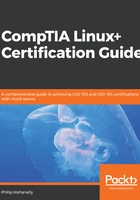
Using Debian Package Management
In the previous chapter, we focused on the steps to install a Linux distribution. We first worked with the concept of a LiveCD, as opposed to a regular installation. We saw how the system could be booted up without having a hard disk. Then we discussed why we would use a LiveCD. After that, we switched our attention to a demo of performing a fresh installation of Linux distribution. Emphasis was placed on the partitioning, particularly the common mount points. Next, we saw how to do an installation side-by-side with a Windows OS. Following this, we carried out a side-by-side installation between Linux distributions.
In this chapter, we will continue our lesson by focusing on the points surrounding software installation. We will begin by looking at the Debian style of package management. First, we will start with the dpkg command, and look at the various methods of using the dpkg command. After this, we will look at the various options which can be passed with the dpkg command. Next, we will turn our attention toward the apt-get utility. This is another popular command for installing applications within a Debian environment. We will pay close attention to the options that can be passed with the apt-get command. Following this, the focus will be switched to the aptitude utility. Finally, we will close the chapter by looking at the synaptic utility. In a similar way to the previous commands, here we will focus on the syntax for deploying software within a Debian environment. All the utilities discussed in this chapter are commonly used for managing software within a Debian environment.
We will cover the following topics in this chapter:
- The dpkg command
- The apt-get command
- The aptitude command
- The synaptic utility